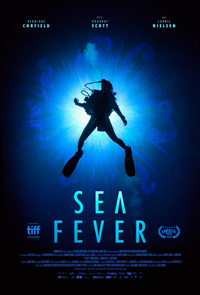Between the Devil and the Deep Blue Sea: Hardiman Finds Humanity in the Horror
 We’ve seen countless films about bands of isolated humans in claustrophobic confines with some terrible monster or entity killing them off, with seminal titans like Ridley Scott’s Alien (1979), itself a riff on Agatha Christie’s Ten Little Indians, and John Carpenter’s The Thing (1981), a remake, as the standards which all predecessors are often (unfavorably) compared to.
We’ve seen countless films about bands of isolated humans in claustrophobic confines with some terrible monster or entity killing them off, with seminal titans like Ridley Scott’s Alien (1979), itself a riff on Agatha Christie’s Ten Little Indians, and John Carpenter’s The Thing (1981), a remake, as the standards which all predecessors are often (unfavorably) compared to.
Director Neasa Hardiman extends the conversation with her sophomore film Sea Fever, which earns comparisons to both those classic titles and adds a timely, evidence-based spin to her tale of a crew accosted by a creature of unknown origin aboard an Irish fishing vessel. Taking care to make her doomed crew multidimensional characters (and girding her familiar bits with mysterious maritime mythology playing off traditional superstitions) goes a long way in a scenario which could have easily played to its comfortable clichés.
Centering Sea Fever is relative newcomer Hermione Corfield, whose Siobhan is the only voice of reason, scientific or otherwise, aboard the Niamh Cinn Orr. Hardiman doesn’t fashion Corfield into another Sigourney Weaver facsimile and much of Corfield’s dialogue takes on eerie prescience concerning the necessity of quarantine and containment. Dougray Scott and Connie Nielsen are effective as Gerard and Freya, both who lose their heads a bit as crew members begin to die.
Nielsen gets one of the best lines of dialogue in her explanation to Siobhan why sailors, as a rule of thumb, don’t learn how to swim—“It’s better to go fast. No one wants to drown slow.” If only such logic could be applied to their need to control the organism they’ve allowed to infect their water supply.
Containing some moments of gore to satisfy those in need of some sensationalism, Hardiman mostly focuses on various facets of human behavior, which makes Sea Fever feel grounded and level headed. While there are some logistical questions about how the creature (effectively displayed as a phosphorescent tentacled-like thing in the depths—a long way off from something like the Shelley Winters/John Huston cheapie Tentacles, 1977) is able to chew through parts of the boat without causing the vessel to sink, it’s an enjoyable addition to a fine tradition of nightmarish sci-fi creature features necessitating extreme human sacrifice to avoid potential decimation of our own species.
★★★/☆☆☆☆☆


